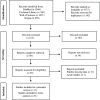Effects of whey and soy protein supplementation on inflammatory cytokines in older adults: a systematic review and meta-analysis
- PMID: 35706399
- PMCID: PMC9975787
- DOI: 10.1017/S0007114522001787
Effects of whey and soy protein supplementation on inflammatory cytokines in older adults: a systematic review and meta-analysis
Abstract
Background and aims: Low-grade inflammation is a mediator of muscle proteostasis. This study aimed to investigate the effects of isolated whey and soy proteins on inflammatory markers.
Methods: We conducted a systematic literature search of randomised controlled trials (RCT) through MEDLINE, Web of Science, Scopus and Cochrane Library databases from inception until September 2021. To determine the effectiveness of isolated proteins on circulating levels of C-reactive protein (CRP), IL-6 and TNF-α, a meta-analysis using a random-effects model was used to calculate the pooled effects (CRD42021252603).
Results: Thirty-one RCT met the inclusion criteria and were included in the systematic review and meta-analysis. A significant reduction of circulating IL-6 levels following whey protein [Mean Difference (MD): -0·79, 95 % CI: -1·15, -0·42, I2 = 96 %] and TNF-α levels following soy protein supplementation (MD: -0·16, 95 % CI: -0·26, -0·05, I2 = 68 %) was observed. The addition of soy isoflavones exerted a further decline in circulating TNF-α levels (MD: -0·20, 95 % CI: -0·31, -0·08, I2 = 34 %). According to subgroup analysis, whey protein led to a statistically significant decrease in circulating IL-6 levels in individuals with sarcopenia and pre-frailty (MD: -0·98, 95 % CI: -1·56, -0·39, I2 = 0 %). These findings may be dependent on participant characteristics and treatment duration.
Conclusions: These data support that whey and soy protein supplementation elicit anti-inflammatory effects by reducing circulating IL-6 and TNF-α levels, respectively. This effect may be enhanced by soy isoflavones and may be more prominent in individuals with sarcopenia.
Keywords: IL-6; Inflammation; Sarcopenia; Soy protein; TNF-α; Whey protein.
Figures



References
Publication types
MeSH terms
Substances
Grants and funding
LinkOut - more resources
Full Text Sources
Medical
Research Materials
Miscellaneous

